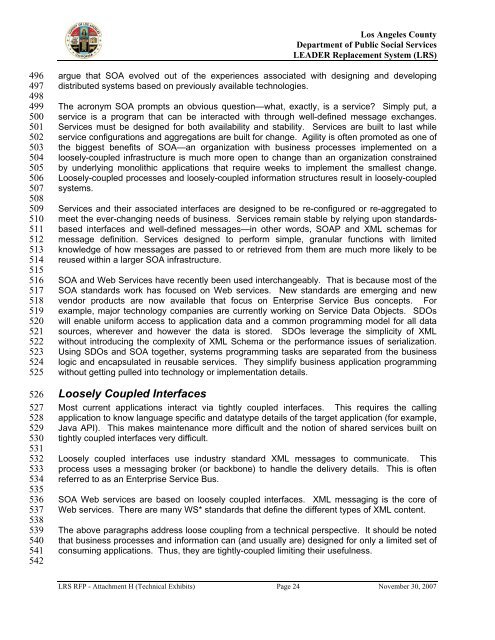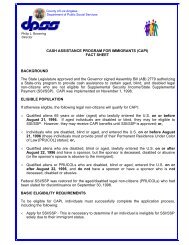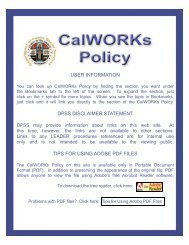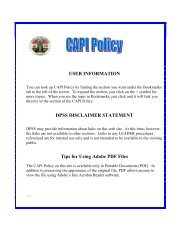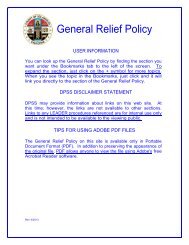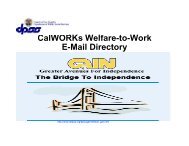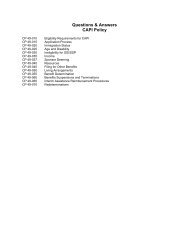leader replacement system - Department of Public Social Services ...
leader replacement system - Department of Public Social Services ...
leader replacement system - Department of Public Social Services ...
You also want an ePaper? Increase the reach of your titles
YUMPU automatically turns print PDFs into web optimized ePapers that Google loves.
Los Angeles County<br />
<strong>Department</strong> <strong>of</strong> <strong>Public</strong> <strong>Social</strong> <strong>Services</strong><br />
LEADER Replacement System (LRS)<br />
496<br />
497<br />
498<br />
499<br />
500<br />
501<br />
502<br />
503<br />
504<br />
505<br />
506<br />
507<br />
508<br />
509<br />
510<br />
511<br />
512<br />
513<br />
514<br />
515<br />
516<br />
517<br />
518<br />
519<br />
520<br />
521<br />
522<br />
523<br />
524<br />
525<br />
526<br />
527<br />
528<br />
529<br />
530<br />
531<br />
532<br />
533<br />
534<br />
535<br />
536<br />
537<br />
538<br />
539<br />
540<br />
541<br />
542<br />
argue that SOA evolved out <strong>of</strong> the experiences associated with designing and developing<br />
distributed <strong>system</strong>s based on previously available technologies.<br />
The acronym SOA prompts an obvious question—what, exactly, is a service? Simply put, a<br />
service is a program that can be interacted with through well-defined message exchanges.<br />
<strong>Services</strong> must be designed for both availability and stability. <strong>Services</strong> are built to last while<br />
service configurations and aggregations are built for change. Agility is <strong>of</strong>ten promoted as one <strong>of</strong><br />
the biggest benefits <strong>of</strong> SOA—an organization with business processes implemented on a<br />
loosely-coupled infrastructure is much more open to change than an organization constrained<br />
by underlying monolithic applications that require weeks to implement the smallest change.<br />
Loosely-coupled processes and loosely-coupled information structures result in loosely-coupled<br />
<strong>system</strong>s.<br />
<strong>Services</strong> and their associated interfaces are designed to be re-configured or re-aggregated to<br />
meet the ever-changing needs <strong>of</strong> business. <strong>Services</strong> remain stable by relying upon standardsbased<br />
interfaces and well-defined messages—in other words, SOAP and XML schemas for<br />
message definition. <strong>Services</strong> designed to perform simple, granular functions with limited<br />
knowledge <strong>of</strong> how messages are passed to or retrieved from them are much more likely to be<br />
reused within a larger SOA infrastructure.<br />
SOA and Web <strong>Services</strong> have recently been used interchangeably. That is because most <strong>of</strong> the<br />
SOA standards work has focused on Web services. New standards are emerging and new<br />
vendor products are now available that focus on Enterprise Service Bus concepts. For<br />
example, major technology companies are currently working on Service Data Objects. SDOs<br />
will enable uniform access to application data and a common programming model for all data<br />
sources, wherever and however the data is stored. SDOs leverage the simplicity <strong>of</strong> XML<br />
without introducing the complexity <strong>of</strong> XML Schema or the performance issues <strong>of</strong> serialization.<br />
Using SDOs and SOA together, <strong>system</strong>s programming tasks are separated from the business<br />
logic and encapsulated in reusable services. They simplify business application programming<br />
without getting pulled into technology or implementation details.<br />
Loosely Coupled Interfaces<br />
Most current applications interact via tightly coupled interfaces. This requires the calling<br />
application to know language specific and datatype details <strong>of</strong> the target application (for example,<br />
Java API). This makes maintenance more difficult and the notion <strong>of</strong> shared services built on<br />
tightly coupled interfaces very difficult.<br />
Loosely coupled interfaces use industry standard XML messages to communicate. This<br />
process uses a messaging broker (or backbone) to handle the delivery details. This is <strong>of</strong>ten<br />
referred to as an Enterprise Service Bus.<br />
SOA Web services are based on loosely coupled interfaces. XML messaging is the core <strong>of</strong><br />
Web services. There are many WS* standards that define the different types <strong>of</strong> XML content.<br />
The above paragraphs address loose coupling from a technical perspective. It should be noted<br />
that business processes and information can (and usually are) designed for only a limited set <strong>of</strong><br />
consuming applications. Thus, they are tightly-coupled limiting their usefulness.<br />
LRS RFP - Attachment H (Technical Exhibits) Page 24 November 30, 2007


